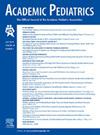Children and Firearms in the United States: Parent and Child Reports on Firearms Use, Storage, and Training
IF 2.8
3区 医学
Q1 PEDIATRICS
引用次数: 0
Abstract
Objective
To explore reasons for having firearms, plus firearms storage, training, and use, among firearm-exposed children aged 10–12, and evaluate parent-child agreement in reporting.
Methods
Survey research was conducted as part of a larger randomized trial. Children aged 10–12, all exposed to firearms and living in the Southeastern United States, and a parent were recruited from community sources. They independently responded to surveys via tablet about family demographics (parents) and firearms use, storage, and training (parents and children). Descriptive data were examined and parent-child comparisons made.
Results
One hundred sixty-three parent-child dyads participated. Consistent with inclusion criteria, both parents (M = 4.4, SD = 5.1) and children (M = 5.3, SD = 11.9) reported high numbers of firearms in the home, with protection (82% parents; 73% children) the most common reason. Both parents (76%) and children (78%) reported children knew where some firearms were stored, but about half (parents 55%; children 41%) reported children were unaware of the storage location for all. Over half of parents (55%) and many children (30%) reported some firearms were kept unlocked. Most parents (81%) and children (73%) reported children had firearm safety training from adult family, but few (<10%) from community or online sources. Both parents (44% hunt; 68% shoot) and children (47%; 60%) reported children hunt and shoot at least annually, occasionally unsupervised.
Conclusions
Understanding how children engage with firearms guides effective prevention. Results reveal children regularly engage in hunting and shooting, occasionally unsupervised; children are sometimes unaware where firearms are stored in their own homes; and children rarely have formal firearms safety training.
美国的儿童和枪支:父母和儿童关于枪支使用、储存和训练的报告。
目的:探讨10 ~ 12岁枪支暴露儿童持有枪支、枪支储存、训练、使用的原因,评价报告情况的亲子认同情况。方法:调查研究作为一个更大的随机试验的一部分进行。年龄在10到12岁之间的儿童,都生活在美国东南部,接触过枪支,父母从社区中招募。他们通过平板电脑独立回答了关于家庭人口统计(父母)和枪支使用、储存和训练(父母和孩子)的调查。对描述性数据进行了检查,并进行了亲子比较。结果:163对亲子对参与。与纳入标准一致,父母(M=4.4, SD=5.1)和儿童(M=5.3, SD=11.9)均报告家中有大量枪支,并有保护措施(82%的父母;73%的孩子)是最常见的原因。父母(76%)和孩子(78%)都表示孩子知道一些枪支存放在哪里,但大约一半(父母55%;儿童(41%)报告说,儿童不知道所有人的储存地点。超过一半的家长(55%)和许多孩子(30%)表示有些枪支没有上锁。大多数家长(81%)和儿童(73%)表示孩子接受过成人家庭的枪支安全培训,但很少(结论:了解儿童如何接触枪支有助于有效预防)。结果显示,儿童经常参与狩猎和射击,偶尔无人监督;儿童有时不知道枪支存放在自己家里的什么地方;孩子们很少接受正规的枪支安全培训。
本文章由计算机程序翻译,如有差异,请以英文原文为准。
求助全文
约1分钟内获得全文
求助全文
来源期刊

Academic Pediatrics
PEDIATRICS-
CiteScore
4.60
自引率
12.90%
发文量
300
审稿时长
60 days
期刊介绍:
Academic Pediatrics, the official journal of the Academic Pediatric Association, is a peer-reviewed publication whose purpose is to strengthen the research and educational base of academic general pediatrics. The journal provides leadership in pediatric education, research, patient care and advocacy. Content areas include pediatric education, emergency medicine, injury, abuse, behavioral pediatrics, holistic medicine, child health services and health policy,and the environment. The journal provides an active forum for the presentation of pediatric educational research in diverse settings, involving medical students, residents, fellows, and practicing professionals. The journal also emphasizes important research relating to the quality of child health care, health care policy, and the organization of child health services. It also includes systematic reviews of primary care interventions and important methodologic papers to aid research in child health and education.
 求助内容:
求助内容: 应助结果提醒方式:
应助结果提醒方式:


